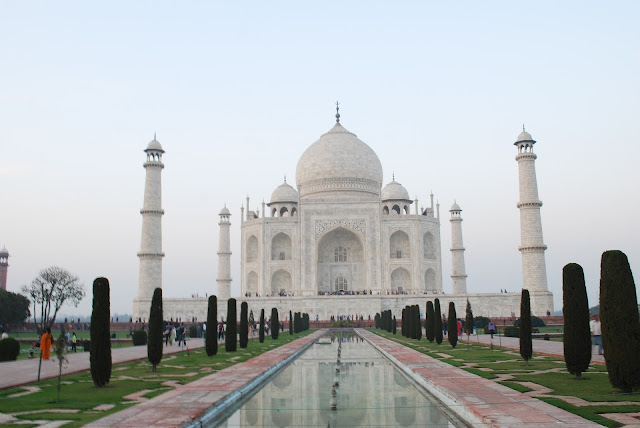Taj Mahal: Some Interesting Facts
The Taj Mahal is a mausoleum located in Agra, India, and was built by the Mughal Emperor Shah Jahan in memory of his wife Mumtaz Mahal, who died during childbirth in 1631. The Taj Mahal is a symbol of love and devotion, and Shah Jahan is said to have been heartbroken after the death of his beloved wife, so he commissioned the construction of this grand monument in her honor.
Construction Of The Taj Mahal
Construction of the Taj Mahal began in 1632 and took 22 years to complete, with a workforce
of around 20,000 laborers, artisans, and craftsmen. The construction of the Taj
Mahal was a massive undertaking that required a vast amount of resources,
manpower, and expertise. The laborers worked tirelessly to carve aand shape the
white marble into intricate designs, while the artisans and craftsmen added
decorative elements such as inlaid semiprecious stones and calligraphy.
The Marbal Used In Construction Of Taj Mahal .
The white
marble used to construct the Taj Mahal was sourced from various regions in
India and transported to the site using a network of elephants, horses, and
oxen. The white marble used in the Taj Mahal is of high quality and was sourced
from different parts of India, including Rajasthan, Gujarat, and Punjab. The
transportation of the marble to the site of the Taj Mahal was a monumental task
that required a huge workforce, with elephants, horses, and oxen all playing a
crucial role in the transportation process.
The Most Beautiful Building In The World
The Taj Mahal is a UNESCO World Heritage Site
and is widely considered to be one of the most beautiful buildings in the
world, with its symmetrical design, intricate carvings, and decorative elements
such as inlaid semiprecious stones and calligraphy. The Taj Mahal's symmetrical
design is one of its most striking features, with each of its four sides being
identical. The intricate carvings and decorative elements, such as the inlaid
semiprecious stones and calligraphy, add to the beauty and elegance of the
building.
The Optical Illusion
The Taj Mahal
is also known for its optical illusions, such as the way the minarets appear to
lean outwards slightly in order to appear vertical from ground level, and the
fact that the calligraphy on the entrance gate appears to be the same size no
matter the distance from which it is viewed. The optical illusions in the Taj
Mahal are a testament to the skills of the architects and designers who created
the building, and they add to the sense of wonder and amazement that visitors
feel when they visit the monument.
The Color Changing Of Taj Mahal
The Taj Mahal
is said to change color depending on the time of day and weather conditions,
with the white marble appearing to turn pink at sunrise, golden at sunset, and
silver under the light of the moon. The changing colors of the Taj Mahal are a
result of the way that the white marble reflects and absorbs light. This
creates a stunning effect that makes the building appear to change color throughout
the day.
The Persian Inspired Garden
The Taj Mahal
is surrounded by a large garden known as the Charbagh, which is divided into
four sections by water channels and is thought to represent paradise in Islamic
tradition. The Charbagh garden is an essential part of the Taj Mahal complex
and is an example of the Persian-inspired garden design that was popular during
the Mughal period. The water channels and fountains within the garden add to
the beauty and serenity of the surroundings and make the Taj Mahal a true
masterpiece of architecture and design.
In the end It's a 8th wonder in the world having lot of attentions worldwide and tourism. Most of the people came from different countries in order to visit that place and capture some memories.












